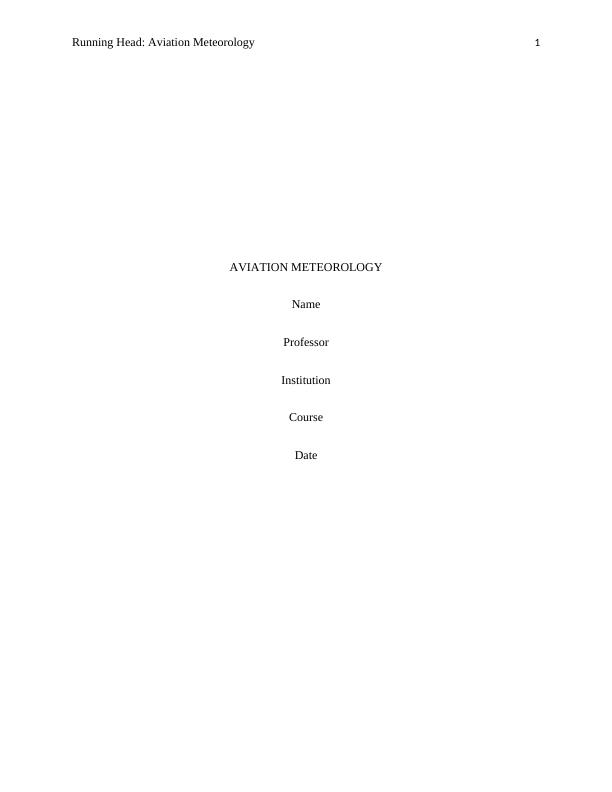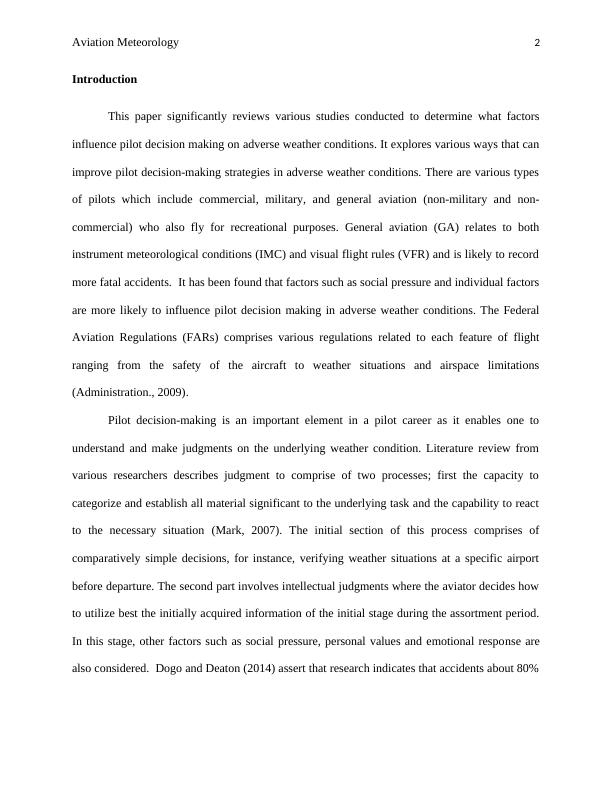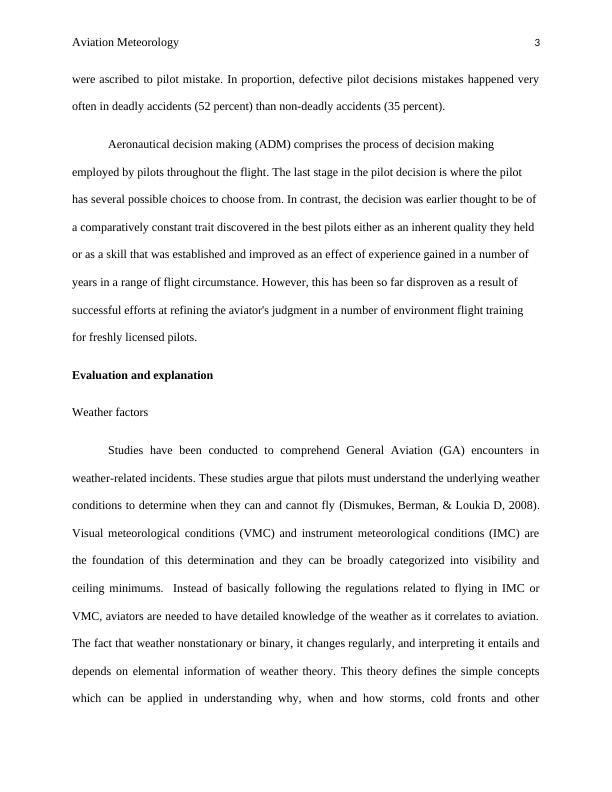Aviation Meteorology
Added on 2023-04-23
8 Pages2075 Words59 Views
Running Head: Aviation Meteorology 1
AVIATION METEOROLOGY
Name
Professor
Institution
Course
Date
AVIATION METEOROLOGY
Name
Professor
Institution
Course
Date

Aviation Meteorology 2
Introduction
This paper significantly reviews various studies conducted to determine what factors
influence pilot decision making on adverse weather conditions. It explores various ways that can
improve pilot decision-making strategies in adverse weather conditions. There are various types
of pilots which include commercial, military, and general aviation (non-military and non-
commercial) who also fly for recreational purposes. General aviation (GA) relates to both
instrument meteorological conditions (IMC) and visual flight rules (VFR) and is likely to record
more fatal accidents. It has been found that factors such as social pressure and individual factors
are more likely to influence pilot decision making in adverse weather conditions. The Federal
Aviation Regulations (FARs) comprises various regulations related to each feature of flight
ranging from the safety of the aircraft to weather situations and airspace limitations
(Administration., 2009).
Pilot decision-making is an important element in a pilot career as it enables one to
understand and make judgments on the underlying weather condition. Literature review from
various researchers describes judgment to comprise of two processes; first the capacity to
categorize and establish all material significant to the underlying task and the capability to react
to the necessary situation (Mark, 2007). The initial section of this process comprises of
comparatively simple decisions, for instance, verifying weather situations at a specific airport
before departure. The second part involves intellectual judgments where the aviator decides how
to utilize best the initially acquired information of the initial stage during the assortment period.
In this stage, other factors such as social pressure, personal values and emotional response are
also considered. Dogo and Deaton (2014) assert that research indicates that accidents about 80%
Introduction
This paper significantly reviews various studies conducted to determine what factors
influence pilot decision making on adverse weather conditions. It explores various ways that can
improve pilot decision-making strategies in adverse weather conditions. There are various types
of pilots which include commercial, military, and general aviation (non-military and non-
commercial) who also fly for recreational purposes. General aviation (GA) relates to both
instrument meteorological conditions (IMC) and visual flight rules (VFR) and is likely to record
more fatal accidents. It has been found that factors such as social pressure and individual factors
are more likely to influence pilot decision making in adverse weather conditions. The Federal
Aviation Regulations (FARs) comprises various regulations related to each feature of flight
ranging from the safety of the aircraft to weather situations and airspace limitations
(Administration., 2009).
Pilot decision-making is an important element in a pilot career as it enables one to
understand and make judgments on the underlying weather condition. Literature review from
various researchers describes judgment to comprise of two processes; first the capacity to
categorize and establish all material significant to the underlying task and the capability to react
to the necessary situation (Mark, 2007). The initial section of this process comprises of
comparatively simple decisions, for instance, verifying weather situations at a specific airport
before departure. The second part involves intellectual judgments where the aviator decides how
to utilize best the initially acquired information of the initial stage during the assortment period.
In this stage, other factors such as social pressure, personal values and emotional response are
also considered. Dogo and Deaton (2014) assert that research indicates that accidents about 80%

Aviation Meteorology 3
were ascribed to pilot mistake. In proportion, defective pilot decisions mistakes happened very
often in deadly accidents (52 percent) than non-deadly accidents (35 percent).
Aeronautical decision making (ADM) comprises the process of decision making
employed by pilots throughout the flight. The last stage in the pilot decision is where the pilot
has several possible choices to choose from. In contrast, the decision was earlier thought to be of
a comparatively constant trait discovered in the best pilots either as an inherent quality they held
or as a skill that was established and improved as an effect of experience gained in a number of
years in a range of flight circumstance. However, this has been so far disproven as a result of
successful efforts at refining the aviator's judgment in a number of environment flight training
for freshly licensed pilots.
Evaluation and explanation
Weather factors
Studies have been conducted to comprehend General Aviation (GA) encounters in
weather-related incidents. These studies argue that pilots must understand the underlying weather
conditions to determine when they can and cannot fly (Dismukes, Berman, & Loukia D, 2008).
Visual meteorological conditions (VMC) and instrument meteorological conditions (IMC) are
the foundation of this determination and they can be broadly categorized into visibility and
ceiling minimums. Instead of basically following the regulations related to flying in IMC or
VMC, aviators are needed to have detailed knowledge of the weather as it correlates to aviation.
The fact that weather nonstationary or binary, it changes regularly, and interpreting it entails and
depends on elemental information of weather theory. This theory defines the simple concepts
which can be applied in understanding why, when and how storms, cold fronts and other
were ascribed to pilot mistake. In proportion, defective pilot decisions mistakes happened very
often in deadly accidents (52 percent) than non-deadly accidents (35 percent).
Aeronautical decision making (ADM) comprises the process of decision making
employed by pilots throughout the flight. The last stage in the pilot decision is where the pilot
has several possible choices to choose from. In contrast, the decision was earlier thought to be of
a comparatively constant trait discovered in the best pilots either as an inherent quality they held
or as a skill that was established and improved as an effect of experience gained in a number of
years in a range of flight circumstance. However, this has been so far disproven as a result of
successful efforts at refining the aviator's judgment in a number of environment flight training
for freshly licensed pilots.
Evaluation and explanation
Weather factors
Studies have been conducted to comprehend General Aviation (GA) encounters in
weather-related incidents. These studies argue that pilots must understand the underlying weather
conditions to determine when they can and cannot fly (Dismukes, Berman, & Loukia D, 2008).
Visual meteorological conditions (VMC) and instrument meteorological conditions (IMC) are
the foundation of this determination and they can be broadly categorized into visibility and
ceiling minimums. Instead of basically following the regulations related to flying in IMC or
VMC, aviators are needed to have detailed knowledge of the weather as it correlates to aviation.
The fact that weather nonstationary or binary, it changes regularly, and interpreting it entails and
depends on elemental information of weather theory. This theory defines the simple concepts
which can be applied in understanding why, when and how storms, cold fronts and other

End of preview
Want to access all the pages? Upload your documents or become a member.
